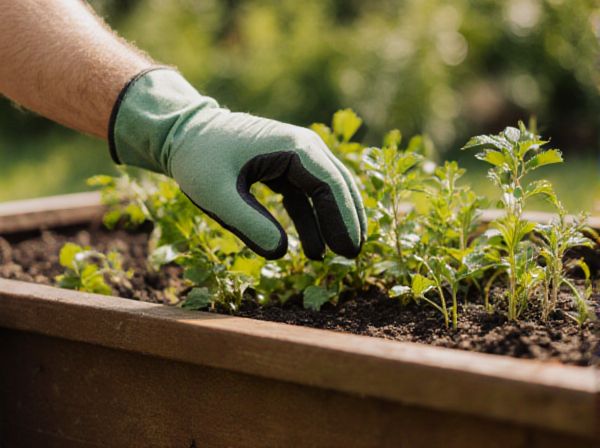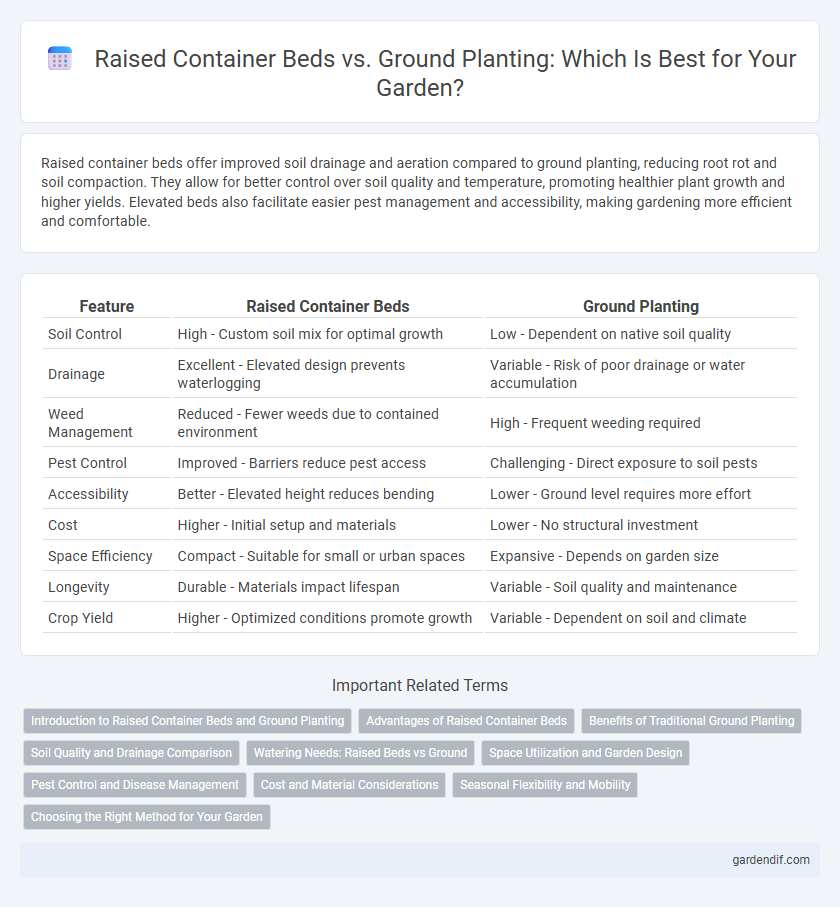
Raised container beds vs ground planting Illustration
Raised container beds offer improved soil drainage and aeration compared to ground planting, reducing root rot and soil compaction. They allow for better control over soil quality and temperature, promoting healthier plant growth and higher yields. Elevated beds also facilitate easier pest management and accessibility, making gardening more efficient and comfortable.
Table of Comparison
| Feature | Raised Container Beds | Ground Planting |
|---|---|---|
| Soil Control | High - Custom soil mix for optimal growth | Low - Dependent on native soil quality |
| Drainage | Excellent - Elevated design prevents waterlogging | Variable - Risk of poor drainage or water accumulation |
| Weed Management | Reduced - Fewer weeds due to contained environment | High - Frequent weeding required |
| Pest Control | Improved - Barriers reduce pest access | Challenging - Direct exposure to soil pests |
| Accessibility | Better - Elevated height reduces bending | Lower - Ground level requires more effort |
| Cost | Higher - Initial setup and materials | Lower - No structural investment |
| Space Efficiency | Compact - Suitable for small or urban spaces | Expansive - Depends on garden size |
| Longevity | Durable - Materials impact lifespan | Variable - Soil quality and maintenance |
| Crop Yield | Higher - Optimized conditions promote growth | Variable - Dependent on soil and climate |
Introduction to Raised Container Beds and Ground Planting
Raised container beds offer superior soil drainage and improved root aeration compared to traditional ground planting, making them ideal for areas with poor or compacted soil. These beds allow precise control over soil composition, moisture levels, and nutrient content, which enhances plant growth and reduces weed intrusion. Ground planting relies on native soil conditions, often requiring soil amendment and is more susceptible to pests and soil-borne diseases.
Advantages of Raised Container Beds
Raised container beds improve soil drainage and prevent compaction, promoting healthier root growth compared to traditional ground planting. They offer easier weed control and pest management, reducing the need for chemical treatments. Elevated positioning also provides ergonomic benefits, making gardening more accessible and reducing physical strain.
Benefits of Traditional Ground Planting
Traditional ground planting promotes natural soil ecosystems that support beneficial microorganisms and earthworms, enhancing nutrient availability and plant health. It allows deeper root growth and better water retention due to the natural soil structure, reducing the need for frequent irrigation. Moreover, ground planting provides larger growing space at a lower cost, making it ideal for extensive crops and larger plants.
Soil Quality and Drainage Comparison
Raised container beds offer superior soil quality control by allowing gardeners to customize soil composition, ensuring optimal nutrient levels and pH balance compared to in-ground planting where soil quality may vary widely. Drainage in raised beds is generally more efficient due to elevated soil layers that prevent waterlogging, reducing root rot risk common in poorly drained ground soil. Enhanced aeration and faster warming of the soil in raised beds also promote healthier root development and improved plant growth.
Watering Needs: Raised Beds vs Ground
Raised container beds retain moisture more efficiently than ground planting due to improved drainage and reduced soil compaction, reducing the frequency of watering. Ground planting often requires more frequent irrigation as soil moisture tends to evaporate faster and can become waterlogged. Selecting raised beds can result in better water management and healthier plant growth in various climates.
Space Utilization and Garden Design
Raised container beds maximize space utilization by allowing vertical layering and efficient organization, making them ideal for small or urban gardens. They enhance garden design with clean edges and customizable shapes, providing a structured and aesthetically pleasing layout. In contrast, ground planting requires more horizontal space and can limit flexibility in garden arrangement and plant proximity.
Pest Control and Disease Management
Raised container beds improve pest control by providing better drainage and minimizing soil-borne diseases compared to ground planting. Elevated containers reduce exposure to soil pests like nematodes and root maggots while allowing easier application of targeted treatments. Improved air circulation in raised beds also decreases fungal infections, enhancing overall plant health and reducing the need for chemical interventions.
Cost and Material Considerations
Raised container beds often require a higher initial investment due to the cost of durable materials like cedar, composite wood, or metal, which offer longevity and resistance to rot and pests. Ground planting generally incurs lower material expenses but may require soil amendments and ongoing maintenance to ensure proper drainage and fertility. Choosing between raised beds and ground planting depends on budget constraints, material availability, and the desired durability and ease of garden management.
Seasonal Flexibility and Mobility
Raised container beds offer superior seasonal flexibility by allowing gardeners to adjust soil conditions and protect plants from early frost or late cold snaps. Their mobility facilitates repositioning for optimal sunlight exposure or shelter during adverse weather, extending the growing season compared to traditional ground planting. This adaptability supports diverse crop rotations and can improve yield by preventing soil-borne diseases common in fixed ground beds.
Choosing the Right Method for Your Garden
Raised container beds offer improved soil drainage, better root aeration, and easier pest control compared to traditional ground planting, making them ideal for gardeners with poor soil quality or limited space. Ground planting benefits from natural soil ecosystems and typically requires less initial setup, suitable for established garden areas with fertile soil. Selecting the right method depends on soil condition, garden size, plant type, and maintenance preferences to maximize growth and yield efficiency.
Raised container beds vs ground planting Infographic

 gardendif.com
gardendif.com